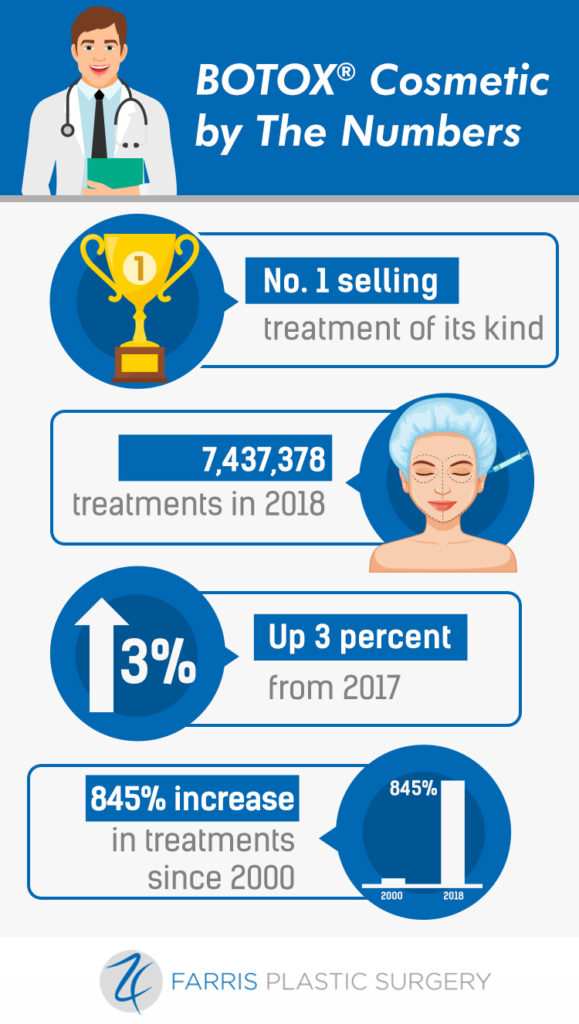BOTOX® Cosmetic is the most popular cosmetic treatment in the United States. More than 7.4 million people used it in 2018 to reduce the appearance of wrinkles and facial lines. Despite, or perhaps because of, its popularity, numerous misconceptions exist about what BOTOX® Cosmetic is and how it works.
Dr. Zachary Farris is a double-board-certified plastic surgeon who is dedicated to helping his patients reclaim smooth, vibrant, youthful-looking skin. He also wants them to be informed about the procedures they’re considering. With that in mind, here are four myths about BOTOX® Cosmetic and why they’re untrue.
Myth: BOTOX® Cosmetic Makes Your Face Look Unnatural

Reality is far from that. BOTOX® Cosmetic relaxes your facial muscles to prevent the repeated muscular contractions that cause wrinkles. It doesn’t paralyze your muscles the way movies and TV frequently depict. The non-surgical, non-invasive procedure has no downtime. You’ll be able to smile, frown, laugh, speak, and eat as normal immediately after your injection.
Myth: BOTOX® Cosmetic Contains Dangerous Toxins
Often, when people learn that BOTOX® Cosmetic is derived from botulinum toxin, they become hesitant to get it. However, there’s no cause for concern. The treatment has been FDA-approved since 1989.
BOTOX® Cosmetic is a purified form of botulinum toxin that is further diluted with a saline solution before injection. It is administered in amounts far below harmful concentration levels. While BOTOX® Cosmetic, like any medical treatment, could be dangerous in the hands of an amateur, it’s perfectly safe when administered by an experienced professional such as Dr. Farris.
Myth: BOTOX® Cosmetic Can Only Treat Visible Signs of Aging
Many people don’t know that BOTOX® Cosmetic wasn’t initially developed for cosmetic purposes. When the FDA first approved the injectable in 1989, it was designed to treat neuromuscular disorders. It can be used for conditions such as:
- Muscle spasms
- Crossed eyes and lazy eye
- Chronic migraines
- Excessive sweating
- Urinary incontinence
If you suffer from any of these conditions, your health care provider may suggest BOTOX® Cosmetic as a treatment. Your dentist may even bring it up to help alleviate temporomandibular joint disorder. As doctors used BOTOX® Cosmetic to treat these ailments, they realized its potential benefits as a cosmetic treatment. It was approved for cosmetic use by the FDA in 2002.
Myth: BOTOX® Cosmetic is for People Middle-Aged and Older
Signs of aging don’t just suddenly appear when you turn 40. Once you reach adulthood, they slowly start to build and become progressively more noticeable. Collagen is the protein that gives your skin its strength and elasticity. It also helps replace dead cells and heal the skin from injuries.
Your body’s collagen production starts to decline by about 1 percent every year starting in your mid-20s. It never comes back. So, by the time you reach your 40s, your body is at least 20 years into its aging process. That means adults of all ages are good candidates for BOTOX® Cosmetic.
The injectable’s effects are cumulative, so your wrinkles become less pronounced every time you get treatment. If you get BOTOX® Cosmetic at younger ages, it can also prevent new wrinkles from forming.
Schedule Your BOTOX® Cosmetic Consultation Today
Dr. Farris wants to help you look and feel your best. He serves patients in the Dallas-Fort Worth area. Call 214-363-1073 today to set up a consultation.

